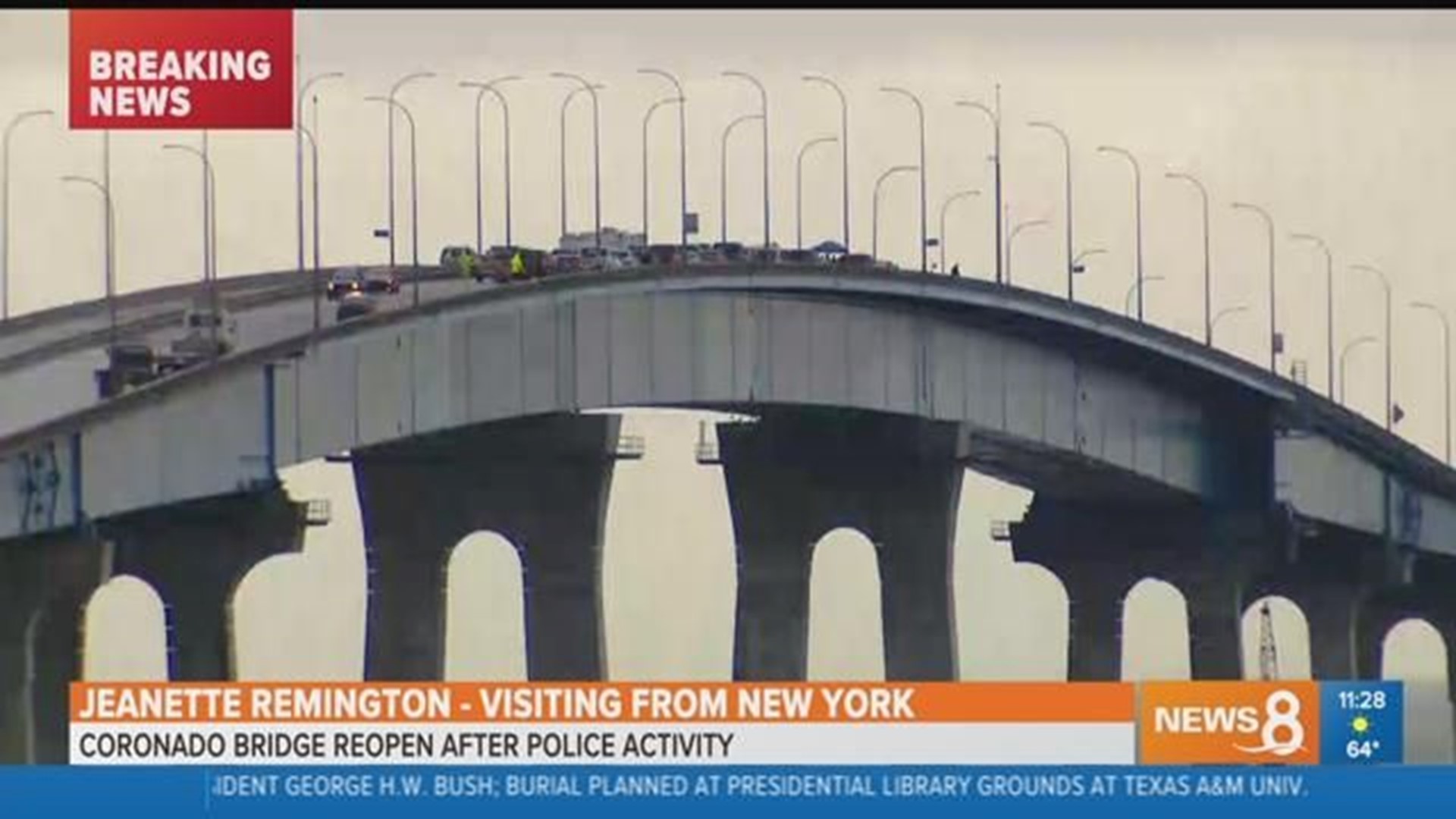Coronado Bridge Jumper Today: The Untold Stories Behind The Headlines
Have you ever wondered what lies beneath the headlines about Coronado Bridge jumper today? It's not just a statistic or a news story; it's a deeply human issue that affects us all. The San Diego-Coronado Bridge, often simply called the Coronado Bridge, has become tragically synonymous with despair. But behind every story is a person, a life, and a reason. Let’s dive into the realities, the struggles, and the hope surrounding this sensitive topic.
When we talk about Coronado Bridge jumper today, we’re not just talking about numbers or trends. We’re talking about lives—people who felt like they had no other way out. It’s a heavy topic, but one that deserves our attention and understanding. This bridge, with its breathtaking views and iconic design, has unfortunately become a symbol of something much darker.
But here’s the thing: there’s more to the story than meets the eye. There’s hope, there’s help, and there’s a community working tirelessly to prevent these tragedies. In this article, we’ll explore the reasons behind the rise in incidents, the efforts being made to address them, and how you can be part of the solution. Let’s get started.
Read also:Caris Levert Rising Star Basketball Maestro And The Future Of The Game
Why Coronado Bridge Has Become a Symbol of Despair
Let’s face it, the Coronado Bridge is an engineering marvel. Stretching over 11,000 feet, it connects the city of San Diego to Coronado Island. But beneath its stunning beauty lies a painful reality. Over the years, it has become one of the most notorious spots for suicides in the country. The reasons? Well, it’s complicated.
Experts say the bridge’s accessibility and height make it a tragically appealing option for those in crisis. But it’s not just about the bridge itself—it’s about the systemic issues that lead people to that point. Mental health stigma, lack of resources, and societal pressures all play a role in this growing epidemic.
Understanding the Stats: Coronado Bridge Jumper Today
Here’s where the numbers come in. According to recent reports, the number of incidents on the Coronado Bridge has been on the rise. In fact, 2022 saw one of the highest recorded numbers of jumpers. But what do these numbers really mean?
Each statistic represents a life lost—a life that could have been saved with the right intervention. The coronado bridge jumper today isn’t just a trend; it’s a wake-up call for society to do better. Let’s break it down:
- Over 400 people have died by suicide on the Coronado Bridge since it opened in 1969.
- Incidents have increased by 20% in the last five years alone.
- Many of these cases go unreported, meaning the actual numbers could be even higher.
Exploring the Root Causes
So, what’s really driving this trend? It’s not just one factor—it’s a combination of mental health challenges, economic stress, and social isolation. Let’s take a closer look at some of the root causes:
Mental Health Stigma
One of the biggest barriers to getting help is the stigma surrounding mental health. Many people feel ashamed or embarrassed to seek support, leading them to suffer in silence. This is especially true in communities where mental health isn’t openly discussed.
Read also:Tayme Thapthimthong White Lotus Season 3 Episode 1 The New Face Of Luxury Chaos
Economic Pressures
San Diego, like many cities, has seen a rise in living costs. Housing, healthcare, and basic necessities have become increasingly unaffordable for many. Financial stress can be a significant trigger for mental health crises, pushing people to the brink.
Social Isolation
In today’s fast-paced world, it’s easy to feel disconnected. Social media, while connecting us in some ways, can also contribute to feelings of loneliness and inadequacy. For those already struggling, this isolation can feel overwhelming.
Prevention Efforts: What’s Being Done?
Thankfully, there are people and organizations working hard to prevent coronado bridge jumper today from becoming a reality. Here’s a look at some of the initiatives in place:
- Barriers and Safety Nets: There have been calls for the installation of physical barriers or safety nets on the bridge to deter jumpers. While this solution isn’t foolproof, it could save countless lives.
- Crisis Hotlines: Hotlines like the National Suicide Prevention Lifeline (1-800-273-TALK) offer immediate support to those in need. Local organizations in San Diego have also set up dedicated lines for residents.
- Community Awareness: Education and awareness campaigns are helping to break down the stigma surrounding mental health. By talking openly about these issues, we can encourage more people to seek help.
Personal Stories: Putting Faces to the Numbers
Behind every coronado bridge jumper today is a story—a family, a friend, a community left behind. Hearing these stories can help us understand the human side of this issue. Here’s one example:
“I lost my brother to the Coronado Bridge last year,” says Maria, a San Diego resident. “He was a loving father, a hard worker, and a friend to everyone. But he was also struggling with depression, and we didn’t realize how bad it had gotten until it was too late. I want people to know that it’s okay to ask for help.”
The Role of Mental Health Professionals
Mental health professionals play a crucial role in preventing coronado bridge jumper today. Therapists, counselors, and psychiatrists work tirelessly to provide support and resources to those in need. But there’s still a long way to go in terms of accessibility and affordability.
Therapy Options
From cognitive-behavioral therapy (CBT) to dialectical behavior therapy (DBT), there are many effective treatments available. The key is making these services accessible to everyone, regardless of income or location.
Medication and Support
For some, medication can be a lifeline. Antidepressants and other psychiatric medications can help manage symptoms of depression and anxiety. But they’re not a one-size-fits-all solution. That’s why therapy and support groups are equally important.
How You Can Help
Preventing coronado bridge jumper today isn’t just the responsibility of professionals—it’s a community effort. Here’s how you can make a difference:
- Be Aware: Educate yourself about the signs of mental health crises. Look out for changes in behavior, mood swings, or withdrawal from social activities.
- Offer Support: If you know someone who’s struggling, reach out. Sometimes just listening can make a huge difference.
- Advocate for Change: Support policies and initiatives aimed at improving mental health resources and reducing stigma.
Resources for Those in Need
If you or someone you know is struggling, there are resources available. Here are a few:
- National Suicide Prevention Lifeline: 1-800-273-TALK
- Crisis Text Line: Text HOME to 741741
- San Diego Access and Crisis Line: 1-888-724-7240
Conclusion: Breaking the Cycle
Coronado Bridge jumper today is a heartbreaking reality, but it’s not one we have to accept. By understanding the causes, supporting prevention efforts, and advocating for change, we can make a difference. Remember, every life matters, and every person deserves hope.
So, what can you do? Start by reaching out to those around you. Check in on friends, family, and even acquaintances. You never know who might need a helping hand. And if you’re struggling, don’t hesitate to reach out for help yourself. You’re not alone, and there are people who care.
Let’s work together to break the cycle and create a world where coronado bridge jumper today is a thing of the past. Share this article, start conversations, and be the change you want to see.
Table of Contents
- Why Coronado Bridge Has Become a Symbol of Despair
- Understanding the Stats: Coronado Bridge Jumper Today
- Exploring the Root Causes
- Prevention Efforts: What’s Being Done?
- Personal Stories: Putting Faces to the Numbers
- The Role of Mental Health Professionals
- How You Can Help
- Resources for Those in Need
- Conclusion: Breaking the Cycle
Article Recommendations


